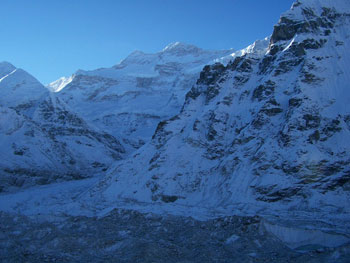Kanchenjunga Conservation Area
 Kanchenjunga is the third highest mountain in the world, bordering Sikkim in India, the Tibetan Autonomous Region of China and east Nepal. The Kanchenjunga Conservation Area (KCA) with an area of 1,650 km 2 accounts for nearly 65 percent of the entire land area of Taplejung District. Because KCA is located due north of Bay of Bangal , KCA receives more rainfall from the summer monsoon than other parts of Nepal. These climatic conditions, combined with steep elevation gradients, support high biodiversity. Surveys indicate that there are at least 2,500 species of flowering plants, and several endangered wildlife species.
Kanchenjunga is the third highest mountain in the world, bordering Sikkim in India, the Tibetan Autonomous Region of China and east Nepal. The Kanchenjunga Conservation Area (KCA) with an area of 1,650 km 2 accounts for nearly 65 percent of the entire land area of Taplejung District. Because KCA is located due north of Bay of Bangal , KCA receives more rainfall from the summer monsoon than other parts of Nepal. These climatic conditions, combined with steep elevation gradients, support high biodiversity. Surveys indicate that there are at least 2,500 species of flowering plants, and several endangered wildlife species.
The cultural diversity within KCA is equally impressive as it contains a number of culturally significant landmarks, including centuries-old monasteries (gompa) and sites of Hindu pilgrimage. Limbu, the largest ethnic population together with the Gurung, Rai, Brahmins and Chhetris as well as Tibetan refugees, inhabit the three river valleys - Tamur, Ghunsa and Sibuwa. A majority of the population are dependent on agriculture and livestock. Harvesting of forest resources contribute much to their subsistence. It is estimated that almost 75% of the households in the Conservation Area face food scarcity every year.
The park and conservation area is situated in the Sankhuwasabha and Solukhumbu districts, bordered by the Arun River on the east, Sagarmatha ( Mt. Everest) National Park on the west, the Nepal-Tibet border on the north and Saune Danda (ridge) to the south. The Park covers 2,330 sq. kms.

